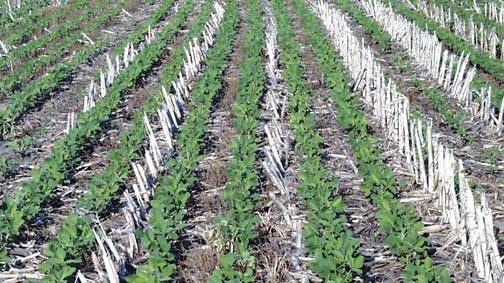Ray Archuleta says the earth is sick. It is in this condition, he says, in large measure due to our disregard of natural principles in our approach to agriculture.

Archuleta is a conservation agronomist with the Natural Resource Conservation Service and he spoke at the No-Till Oklahoma Conference being conducted Tuesday and Wednesday in Norman. When he is not traveling the countryside, he teaches soil health and the principles of agroecology at the NRCS East National Technology Center in Greensboro, North Carolina.
Radio Oklahoma Network Farm Director Ron Hays is at the no-till conference and spoke with Archuleta about his promotion of these revolutionary ideas. (You can hear their full conversation by clicking on the LISTEN BAR at the bottom of this story.)
“No-till is a wonderful tool, but what we’re telling farmers, too, is that no-till is not enough. You’ve got to do it with covers and, more, we’re trying to push the thought process ‘farm in nature’s image.’ Nature doesn’t till, so we don’t want to till. But no-till is just a part of the big story.”
Archuleta offered no-till conference attendees a number of principles to help guide their work. Principal among those was keeping the ground covered. He says the soil in forests is covered 24-7 with a diversity of plants and it is that architecture that he is trying to mimic both top and bottom.
“What you see on the top is what you’re going to emulate on the bottom. So we want to see that massive root system and feed carbon into that soil ecosystem. That’s what we want to do.”
Archuleta said that process helps the soil to function.
“If we can increase soil function it means we are getting a better nutrient cycle; we’re going to hold water better. For every one percent of organic matter that we build in the soil, we can hold anywhere from 17 to 25,000 more gallons per acre. That is huge. So, what we are saying is those covers will help stop the kinetic energy of raindrops-slow it down-so rain enters into the soil slowly. It protects it from the heat. It shades it; it keeps it cool. But, most importantly, it feeds the soil microbiology which runs the soil ecosystem.”
Becoming a no-till farmer and reaping the maximum benefits of these practices is not an overnight proposition, Archuleta said. Farmers have got to become committed students who will be patient with the process and, also learn from their failures.
The good news, Archuleta said, is that those failures turn into success stories. He related the story of Gabe Brown, a farmer in North Dakota, was going broke before he adopted no-till practices.
“What he did was he went to no-till, he started using covers and then he started running his cows like buffalo and he was integrating the cropping and grazing systems together. So, he saved the farm. Now he’s making great money.”
He said another farmer following in Brown’s footsteps has had tremendous success. After three years of no-till farming, his wheat now produces 78 to 83 bushels per acre. He’s got great yields on soybeans. So, he shifted his whole farm by watching other farmers do the same thing.
“What we’re saying is that if you get the soil so healthy and cycling it will cycle the nutrients for you so you don’t have to buy so much fertilizer. And when you bring all the diversity and you’ve got the beneficial insects, you’ve got less fungicides, less insecticides, less herbicides because you’re using the covers to suppress weeds. The best way to control weeds is biological covers. So, you’re synergizing. You’re bringing all these things into synchrony to create synergy in the system.”
Currently, Archuleta said, there are huge swaths of the earth’s surface that are uncovered and bare using conventional farming techniques. This radiates heat which changes both the microclimate and the macroclimate.
“Everything is connected. So we’re saying if we can cover the soil we can do huge, huge things to heal our planet.”
He said that would lower soil temperatures almost immediately which would, in turn, sequester more carbon, hold more moisture, reduce runoff and fix the water cycle.
Click here to see more...